Hello there! 😀
Today I am back with a recipe for an extremely simple yet effective serum… however there are a couple of things I need to say first!
1) This serum is formulated to help a problematic skin. With this I intend a skin which suffers of mild blemishes every now and then, maybe a little irritated and with a few red marks left by previous spots, add an oily T-zone… and that should be it 😀 . The ingredients of this serum will HELP the skin keep hydrated, will help keeping the oiliness under control and will help to soothe the skin (it might also have some effect against the red marks). Obviously, this serum is NOT A CURE for acne or for serious condition skins: it is just a help. I want to underline this because too often, online, we read about “the final cure for blablablaaa” but those are almost cheats 😀
Well… now that you have this “critic eye” opened… let me introduce you to my new and amazing (now I can say it ahahah 😀 ) serum recipe! 😀
No wait!!! There is still another thing I NEED to say…
2) To make this serum you will be using an ingredient which might be dangerous if not used properly. To not make this experience a dangerous one, it is MOST IMPORTANT that you own professional pH TEST STRIPS (or a pH controller… even better).
If you don’t own them and you are not willing to buy them… then stop reading now and don’t attempt making this serum cause you might get seriously hurt. No joking.
This recipe contains NIACINAMIDE (also known as Nicotinamide, Vitamin PP, Vitamin B3 or Nicotinic Amide: they are all the same thing!).
This is an ingredient which works really great on skin; as I already mentioned above, it has anti-inflammatory properties, soothing properties (if used up to 2%) and it helps fighting blemishes (at concentration up to 4%), it normalizes sebum production and it also helps against any discoloration of the skin. Wonderfullll!!!
So where is the trick? 😀
As you might have guessed from the name, this Nicotinamide is a close close friend of Nicotinic Acid; it is, in fact, the amide of nicotinic acid and this acid causes flushing and burning sensation of the skin (definitely the opposite of the soothing property we are looking for…). If you happen to apply nicotinic acid to your face, you might really ruin your skin… so let me tell you what happens when we try to make our serum with Nicotinamide and why it is VERY IMPORTANT that you own pH TEST STRIPS!
Nicotinamide is stable at a pH range between 5.5 and 7. If your serum has this pH, you are having Niacinamide in it.
However, if the pH is too acid (or even too basic), the Niacinamide goes through a reaction and the Nicotinic Acid is formed.
This is why it is very important you have good quality pH Strips (something like THESE and NOT these: the first, in fact, show you more precisely the pH) and you follow the “how to” very well: because if the pH of your serum is not right, you might not have Niacinamide in it anymore, but you might have Nicotinic Acid.
I hope this was very clear.
Now… to the recipe! 😀
RECIPE:
Water to 100 (HERE the explanation)
Niacinamide 4
Aloe Vera powder 0.5
Betaine (also known ad Trimethylglycine – it is NOT the surfactant: it is a powder with soothing properties) – 5
Glycerin 1
Sodium Hyaluronate 0.9 (this is a great active, it promotes deep hydration of the skin and in this formula it is also used as the “gelling agent” 😉 )
Preservative (water based) – use it at the concentration needed. I use an Ecocert approved preservative which needs a 0.6% concentration. Of course you need to use your preservative according to its own needed %.
Extras: one drop of green, food grade and water based colorant (or any color you like) and fragrance oil of cosmetic grade, obviously (one drop is enough and if you add more your fragrance oil will come back to the surface because we haven’t added any emulsifier in this formula: I chose cucumber!) 😀
HOW TO:
1) Measure the water in a becher
2) Add the Aloe Vera Powder, the Glycerin, the Betaine and the preservative to the water.

3) Now it is time to measure the pH!
– If it is between 5.5 and 7 – PERFECT proceed to point 4)
– If it is lower than 5.5 – you need to add a substance which is a strong base and will make the pH rise. When I made this gel, the pH was lower than 5.5, therefore I added a very small amount of SAP (sodium ascorbyl phosphate – a stabilized form of Vitamin C). If you don’t have SAP or any other strong base, you could use a solution of water and 10% sodium hydroxide (but NOTICE: sodium hydroxide is a potentially dangerous ingredient and for this gel you will need a drop or two of this solution… however, because of the dangerous effect it might have, use precautions and therefore wear gloves and goggles whenever you are making or using this solution). Obviously you don’t just add a drop and then proceed to point 4: you add a drop, you wait a couple of minutes while stirring and you return to point 3.
– If it is higher than 7, add a drop of lactic acid or citric acid. Once again, after you add the drop, you mix for a couple of minutes and you return to point 3 (you measure the pH again and you check).
Repeat until you are inside the pH range you need!
4) Add the Niacinamide and stir (and check the pH again! Yes! Again!)
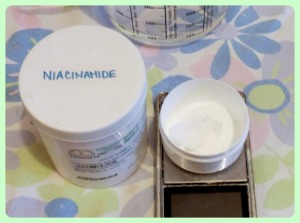

5) Finally add the Sodium Hyaluronate: just pour it on top of the water and forget about the serum for a day.
The pH of Sodium Hyaluronate should be around 7, therefore it shouldn’t have a bad effect on our serum, however, just to be sure, measure the pH once again and check that it is between 5.5 and 7! If it is not… adjust it again as explained on point 3.

This is how it looks as soon as you pour it: you will notice that it will immediately start forming the gel from the top of the solution. Seriously if you are patient it would be best to just let it sit for some hours: it will hydrate slowly and naturally.
However, if you are restless like me 😀 you can mix with a spatula and then use an immersion mixer… this is how it will look like in the beginning (but after few hours it will become transparent again 😉 ).
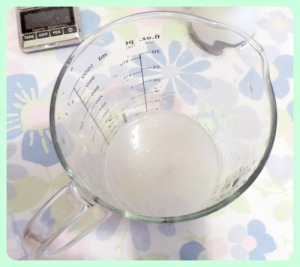
6) If you like it you can add a drop of food grade and water-based colorant and a drop of fragrance oil (if it is just one drop, it will be fine).
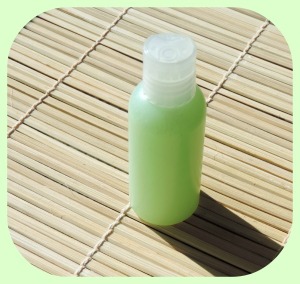
WARNING: even if you follow the procedure very well, it might happen that something goes wrong (for example your pH strips are not very precise)… this is why I warmly suggest you try a very small amount of this gel behind your ear as a test.
If you feel itching or a burning sensation, just wash it off and throw away the serum.
If, instead, everything feels good, you can apply it to your face (needless to say: if it didn’t itch behind the ear and it does itch on your face… then you should still wash it off and throw it away 😀 ).
But hopefully, everything will go right 😀
Hope you enjoyed this recipe and hope it will help your skin to look a bit better! 😀
It did help mine! 😀
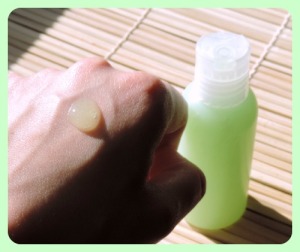
I have also posted a recipe for a Hyaluronic Acid Serum with Rose Water and anti-aging active ingredients, so if this is what you are looking for, you might want to check HERE
If, instead, you want to learn how to make a simple 100% Hyaluronic Acid gel, then click HERE
You can find the list of all my recipes HERE
Have a great day! 😀
And write me a comment if you feel like 😀 : they make my day! 😉

This work is licensed under a Creative Commons Attribution-NonCommercial-NoDerivatives 4.0 International License.
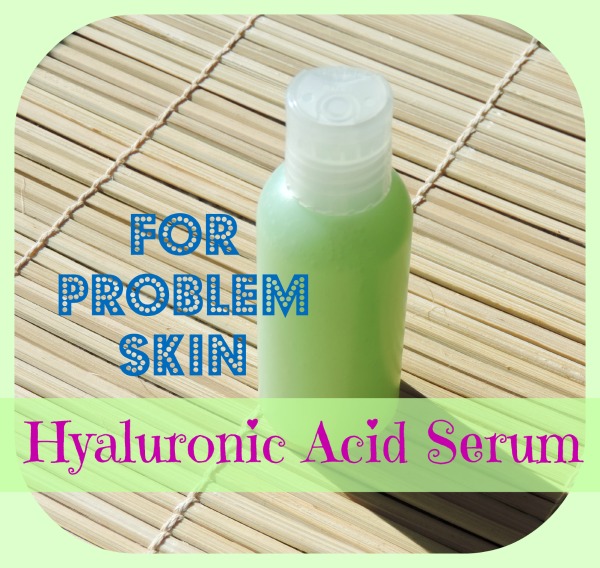

Hello there, this sounds interesting, but I wonder what makes it gel? Is it aloe? Hyaluronic acid is horribly expensive and I haven’t worked with it yet,but hopefully one day I’ll get it for my serum and creams. Also, I wouldn’t add any fragrance and particularly not colours, maybe some essential oil instead.
My best regards,
Maja
LikeLike
Sodium hyaluronate costs approx 2.5 euro per gram. If you buy more than one gram you can pay it around 1.5 per gram.
You need 1 gram to make 100 grams of product and it is the ingredient which makes the gel (because it bounds with water).
I don’t think it is so expensive 🙂
You can choose to add essential oils but remember to add only one drop or it will come to the surface (in fact there are no emulsifiers in this formula)… And avoid citrus essential oils if you use this serum during the day (to avoid fotosensibilization) 😉
LikeLike
Do you think it will be fine to ass willow bark extract to this serum?
LikeLike
Hello Iolax. If “ass” was supposed to be “add” I don’t see why not.
Just be sure the extract is water soluble and the pH is compatible. Adjust the amount of water accordingly 😉
LikeLike
Oops! sorry about the typo. and thanks for your response. Will go try it out.
LikeLiked by 1 person
SOAP acid how you using it to elevating oh
LikeLike
SOAP acid? What do you mean?
LikeLike
Sap acid how elevating ph
LikeLike
Hi, I’m interested in this formula therefore would like to try it out. However, I do not have Betaine on hand, so could I just replace it with 5% of Kaolin instead as i know kaolin can also helps to soothe our skin.
Thank you.
LikeLike
or can I use 5% of Oat Kernel instead?
LikeLike
Oat kernel oil? Or what do you mean
LikeLike
Hello, no it is not a good substitutio because kaolin is NOT soluble and it being a powder it is going to destabilize your emulsion and bring a lot of preserving-related issues.
It is better to simply omit betaine and add 5% of water 😉
LikeLike
Hello, thank you for all your interesting articles !
May I know if it’s alright to use Niacinamide (Vit B3 ) powder in my Hyaluronic acid serum while I’m also applying Vit C serum? I need all that I can find to get rid of pigmentation problem.
Thank you very much for you kind advice:-)))
LikeLike
Hello,
No I wouldn’t use them together because of pH reasons.
You can use one them in separate days or anyway after having washed off the other 🙂
LikeLike
Hi again, I’ve purchased the Vitamin B3 (Niacinamide) on line, and just added 1% of the powder into my Hyaluronic Acid serum. Following your helpful instructions, I did get a pH6 but when I tested it on my inner arm, the skin flushed and redness appeared. I’m wondering if it’s possible that I’m allergic to Vitamin B3? (I’ve searched for days for reasons but to no avail.) I’d appreciate it if you would help me find the cause? (my skin is hardly allergic to products.) I can even use Vitamin C which is pretty acidic….
Thank you very much again in advance for your precious technical advice!
LikeLike
Did you purchase this ingredient from a cosmetic ingredients retailer?
Try rising the pH and reaching closer to pH 7 and try then on your arm.
I am no specialist for allergies, but I do know Niacinamide can cause this kind of reaction when it has become nicotic acid.
It might be that the pH is NOT actually 6 (did you check it with strips or with a pH meter? was the pH meter tested to be sure it signs the right pH?), or that there is some issue in the ingredient you purchased.
Try rising the pH closer to 7. Does it give you the same reaction?
LikeLike
Thank you so much for your kind reply. I still am thankful that I managed to make the Hyaluronic acid serum and I may have to leave this for the time being as I dont have the ingredient to play around with the pH :-))) I think it’s somehow an allergy in my case. I bought the powder On Line.
LikeLike
Hello,
Could I add the preservative at the end of formulation? Or is there any specific reason for adding preservative before niacinamide and sodium hyaluronate? Thanks!
LikeLike
If you add it before, when the water is still in liquid form (not gelled) you can be sure it is well mixed in. That’s all
LikeLike